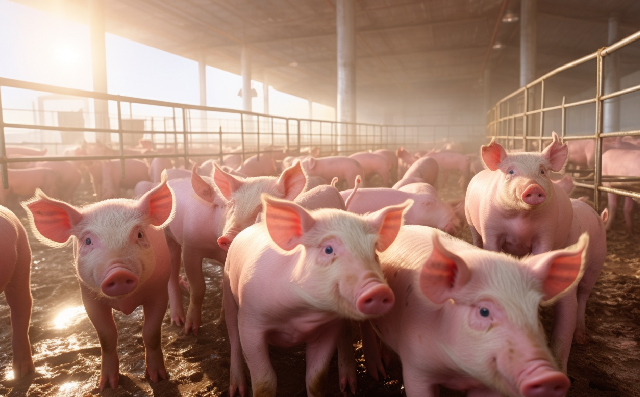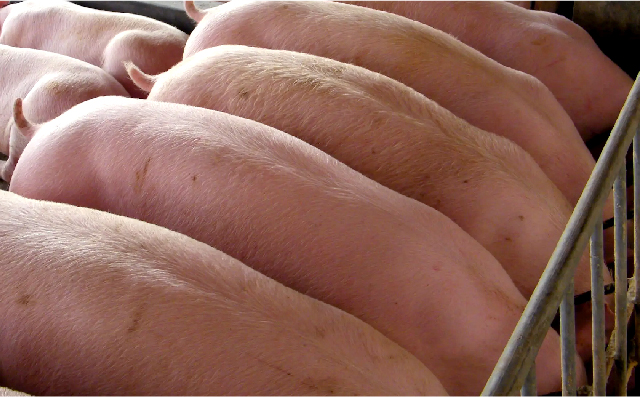从以下两篇摘要的内容来看,肉猪料添加胆碱对生长速度、料肉比都没有效果。这和其他研究得到的结论是一致的。
低蛋白日粮的效果,不同研究结论是不一致的。做的好的,低蛋白日粮补充氨基酸可以达到高蛋白的效果。一般来说,在小猪料阶段添加氨基酸降低蛋白比较容易,而在大猪阶段,本来蛋白就不高了,再降低蛋白就容易导致生产性能的下降。
摘要1, Dietary Supplementation of Choline and Potassium in Low Crude Protein Diets on Growth and Carcass Performance of Finishing Pigs.
J A Soto, M D Tokach, S S Dritz, J C Woodworth, J M DeRouchey …
Journal of Animal Science, Volume 96, Issue suppl_2, April 2018, Page 126, https://doi.org/10.1093/jas/sky073.233
Published: 10 April 2018
试验一: 肥育后期的大猪(初始体重112.2公斤)饲喂正常蛋白饲料(12%蛋白)或低蛋白饲料(10%蛋白,补充氨基酸),生长速度和采食量没有显著差别,但12%蛋白饲料的料肉比略好(P=0.085)。
低蛋白饲料补充0.03%胆碱没有任何效果。添加0.24%钾盐也没有效果。
试验二:初始体重110.5公斤大猪,饲喂两种不同蛋白水平的日粮(12%或10%蛋白,赖氨酸水平相同),添加或不添加胆碱(胆碱添加水平是每吨料1814克)。相对于10%蛋白饲料,12%蛋白饲料日增重略好(P=0.076),料肉比改善(P=0.020)。无论是12%蛋白日粮,还是10%蛋白日粮,添加胆碱都没有作用。
以下为英文摘要部分内容:
Two experiments were conducted to determine the effects of added choline or potassium in low CP diets in finishing pigs.
In Exp. 1, 284 pigs (DNA 600 × 241, initially 112.2 kg BW) were used in a 26-d trial. Pens of 7 or 8 pigs were allotted by BW and randomly assigned to 1 of 4 dietary treatments in a RCBD with 9 replications per treatment. Treatments included a 12% CP, positive control diet with 10.6% SBM, a 10% CP; negative control (NC) diet with 4.0% SBM; NC with added choline (0.03%); or NC with added potassium (0.24%), such that the added choline or potassium matched the amount that is provided in the 12% CP diet. There was no evidence for differences in ADG (0.84, 0.82, 0.82, and 0.82 kg) or ADFI (2.83, 2.93, 2.97, and 2.93 g); however, there was a marginal improvement (P=0.085) in G:F (0.298, 0.279, 0.274, and 0.279) for pigs fed the positive control diet with 12% CP compared with the mean of pigs fed the diets with 10% CP.
In Exp. 2, 254 pigs (DNA 600 × 241, initially 110.5 kg BW) were used in a 19-d trial. Pens of 7 or 8 pigs were allotted by BW and randomly assigned to 1 of 4 dietary treatments in a RCBD with 8 replications per treatment. Experimental treatments were arranged in a 2 × 2 factorial with main effects of CP (12% or 10%) and added choline (0 or 1,814 mg/kg). Pigs fed diets with 12% CP had marginally increased (P=0.076) ADG (0.67 vs 0.62 kg/d) compared with pigs fed diets with 10% CP which resulted in a heavier (P=0.036) final BW (123.2 vs 122.2 kg). Pigs fed the diets with 12% CP also had improved (P=0.020) G:F (0.264 vs 0.245) compared with pigs fed the 10% CP diets. Addition of choline did not influence performance.
In summary, supplementing diets with choline or potassium did not influence growth performance or carcass characteristics of pigs fed low CP diets.
摘要2, Evaluation of Supplementation of Potassium Chloride and Choline Chloride in High Feed Grade Amino Acid Finishing Diets.
L Ochoa, A Graham, L Greiner, B Knopf, M A D Goncalves …
Journal of Animal Science, Volume 96, Issue suppl_2, April 2018, Pages 185–186, https://doi.org/10.1093/jas/sky073.341
Published: 10 April 2018
初始体重31公斤的小猪,饲喂高蛋白日粮(L-赖氨酸盐酸盐添加量为0.15%)、中蛋白日粮(L-赖氨酸盐酸盐添加量为0.35%)或低蛋白日粮(L-赖氨酸盐酸盐添加量0.55%)对日增重、料肉比都没有影响。
低蛋白日粮额外补充0.05%胆碱和0.2%氯化钾对生产性能没有作用。
总的看来,31公斤以上小猪的饲料蛋白水平不低于13%的情况下,把氨基酸补充够了,就不影响生产性能。添加胆碱没有作用。
以下为英文摘要部分内容:
One thousand one hundred and ninety-one PIC (337 X Camborough) barrows and gilts were used to determine the impact of adding potassium chloride and choline chloride to diets containing high feed grade amino acids. Prior to the start of the study, pigs were fed a basal diet that contained 1.35% SID lysine for three weeks. At the start of the study, the pigs averaged 31.0 kg. Pigs were sorted by gender and placed into blocks with 23-25 pigs per pen. Blocks were set for the 4 treatments (0.15% L-lysine HCl, 0.35% L-Lysine HCl, 0.55% L-Lysine HCl, and 0.55% L-Lysine HCl+0.2% potassium chloride+0.05% choline chloride) within gender of similar weights with the block. The diets consisted of corn, soybean meal and dried distiller’s grains and were balanced for SID lysine and SID Lys:ME. All other nutrients met or exceeded NRC (2012) and PIC (2016) recommendations.
Overall, there were no significant differences in average daily gain (0.96, 0.98, 0.98, and 0.97 kg/d; P>0.10) or feed to gain (0.38, 0.39, 0.39, 0.39; P>0.10) between dietary treatments.
In conclusion, the feeding of high levels of feed grade lysine when crude protein remains above 13% crude protein does not impact performance. Furthermore, the addition of potassium chloride and choline chloride did not influence performance.
编译:刘海君
— End —






